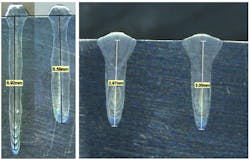Project Paves the Way for Industrialization of Laser in Vacuum Welding
Cambridge Vacuum Engineering (CVE), the power beam welding specialist, has successfully completed a Knowledge Transfer Partnership (KTP)* with Cranfield University that will increase welding options available to engineers worldwide. Together, the two organizations have solved the undesirable optics contamination phenomenon associated with Laser in Vacuum welding, paving the way for full-scale industrial exploitation of the technology.
The conclusion of the KTP will give tangible benefits for companies that want to achieve deeper penetration welds, while also improving weld quality, reducing oxidation, and minimizing the time needed for part cleaning, post welding.
Laser in Vacuum welding is a relatively new joining technique that can be used to tackle some of the most demanding welding tasks. The technique can achieve two to three times the depth of weld compared to conventional laser welding methods. However, to date, the issue of optics contamination** has hindered its widespread adoption across the industry.
With a shared vision to drive forward innovation, CVE and Cranfield University joined forces to research innovative solutions to this persistent issue and integrate Laser in Vacuum welding into various industrial applications.
Over the last two years, the teams set up test systems at both CVE and Cranfield to study different aspects of the process and trial various concepts and solutions. Experiments provided the team with numerous data on various phenomena associated with optical contamination, as well as the secondary effects of the potential identified solutions. This data was then used to develop a unique optics protection system—using a first principles, physics-based approach—that operates effectively with very low levels of particulate generation.
Several trials were conducted with customers, providing further assurances about the capabilities of Laser in Vacuum welding, and validating weld quality in a range of applications, materials, and joint configurations.
Cambridge Vacuum Engineering is now building Laser in Vacuum welding machines featuring the technology for its customers in the industry.
CVE’s optical protection system ensures cleanliness levels of welded parts comparable with electron beam welding while guaranteeing a long laser coupling-in window life. The low-cost consumable windows last for up to three hours of welding at low power (3 kW) with no appreciable weld degradation.
“Laser welding in vacuum can overcome many limitations of atmospheric laser welding, opening a myriad of new applications. Working with Max and the CVE team enabled us to put the required expertise together quickly and develop this technology very efficiently, making a real impact. I look forward to seeing this technology revolutionizing thick section and specialized welding applications," said Dr. Wojciech Suder, Senior Lecturer at Cranfield University.
Laser in Vacuum welding complements electron beam and standard laser welding techniques, with each approach possessing different strengths and weaknesses. Offering all three types of welding, Cambridge Vacuum Engineering can take a technology-agnostic approach, providing customers with bespoke solutions optimized to meet different application needs and engineering challenges.
Laser in Vacuum welding is most suited to projects where higher penetration welds are required or gas-sensitive materials are used. In these scenarios, standard laser welding can struggle to achieve the right results. Many of the process variables influencing weld quality associated with standard laser welding, such as shielding gas composition, nozzle design, and melt pool instabilities, are eliminated using a vacuum.
Aquasium Technology Ltd, trading as Cambridge Vacuum Engineering (“CVE”), designs and builds process solutions and has more than 60 years of experience manufacturing electron beam (EB) systems in a range of industrial sectors including aerospace, nuclear, automotive, oil & gas, and sensors. CVE’s range of EB welding equipment includes systems ranging from 50 to 200kV with beam powers up to 100 kW. camvaceng.com
Cranfield is a specialist postgraduate university that is a global leader in education and transformational research in technology and management. It focuses on the specialist themes of aerospace, defense & security, energy & sustainability, environment & agrifood, manufacturing & materials, transport systems, and water. For more information, go to: www.cranfield.ac.uk


